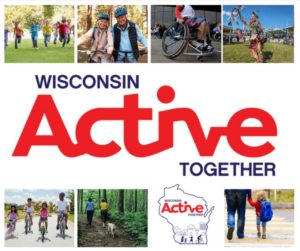Wisconsin Active Together names three new communities! Check out their work to advance strategies for safe places to walk, bike and be active! Continue reading “Wisconsin Active Together recognizes new communities”
Continue reading “Wisconsin Active Together recognizes new communities”
Health benefits
Inaugural ‘Good Health Grows on Trees’ conference a success!
Whether it be a hike through the woods, time spent with your family at a local park or sitting beneath the shade of that stately red oak in your backyard, we, as urban forestry professionals and enthusiasts, experience and recognize the physical, mental and spiritual benefits of spending time outdoors in nature.
For decades, scientists have been researching and documenting the health benefits that trees and nature provide, and as urban populations continue to rise, the impact of nearby nature on human health has generated a lot of interest in our world of urban and community forestry.
To further that conversation in Wisconsin, the first ever ‘Good Health Grows on Trees: The Influence of Nearby Nature on Public Health’ conference was hosted by the DNR Urban Forestry program at the Rotary Botanical Gardens in Janesville on May 30th. Continue reading “Inaugural ‘Good Health Grows on Trees’ conference a success!”
Trees clean the air and prevent respiratory illness
May is National Asthma and Allergy Awareness Month. Did you know trees help prevent asthma and other respiratory diseases? Trees filter particles out of the air we breathe, which decreases our risk of respiratory illnesses, including asthma. One study found that in 2010, trees removed 17.4 million tons of air pollution across the US, which prevented 850 human deaths and 670,000 cases of acute respiratory symptoms. Continue reading “Trees clean the air and prevent respiratory illness”
Trees proven to connect people and build community
Trees help build stronger neighborhoods. Residents in areas with more trees and other greenery know their neighbors better, socialize more often, have a stronger sense of community, and feel safer and better adjusted. Continue reading “Trees proven to connect people and build community”
Trees for Healing
Trees help your body heal. They boost your immune system, help you recover faster, and you’ll need fewer pain relievers. Continue reading “Trees for Healing”
Help your heart by planting trees
February is American Heart Month. Get heart healthy the easy way, head outside! Exposure to trees relaxes and restores your mind, lowering your blood pressure and heart rate. This helps to reduce incidences of cardiovascular and lower respiratory diseases. Conversely, tree loss from the spread of the emerald ash borer, and other insects and diseases, is associated with increased mortality related to cardiovascular and lower respiratory diseases.
Trees help achieve resolutions to be healthy
The sedentary lifestyle has become more common, and the shift has been costly. One result is an increase in obesity. Childhood obesity rates have tripled (12–19 years old) or quadrupled (6–11 years old,) and adult rates have doubled since the 1970s. Obesity increases risk of chronic diseases and conditions such as: high blood pressure, high cholesterol, diabetes, heart disease, stroke, gallbladder disease, osteoarthritis, sleep apnea, cancer and mental illness. This rise in chronic diseases related to obesity results in billions of dollars in medical costs and lost productivity each year. Continue reading “Trees help achieve resolutions to be healthy”
A new year for making Wisconsin Active Together
Walk, Ride, and Roll Our Way to Thriving Communities!
 Wisconsin Active Together starts 2019 by recognizing fourteen new communities from across the state for their efforts to promote active lifestyles and for their pledge to do more–because in addition to celebrating accomplishments, communities can make resolutions to foster health too! Where we live impacts our wellness and the newly named Wisconsin Active Together Communities, now reaching 1.4 million Wisconsinites across the state, know that even small changes in the landscape and in promoting physical activity can add up to creating lasting changes for everyone’s benefit. And your community can now also apply to be recognized in 2019 for its commitment to advancing strategies for safe places to walk, bike, and be active while getting connected to resources, training, and a peer network of experts. Continue reading “A new year for making Wisconsin Active Together”
Wisconsin Active Together starts 2019 by recognizing fourteen new communities from across the state for their efforts to promote active lifestyles and for their pledge to do more–because in addition to celebrating accomplishments, communities can make resolutions to foster health too! Where we live impacts our wellness and the newly named Wisconsin Active Together Communities, now reaching 1.4 million Wisconsinites across the state, know that even small changes in the landscape and in promoting physical activity can add up to creating lasting changes for everyone’s benefit. And your community can now also apply to be recognized in 2019 for its commitment to advancing strategies for safe places to walk, bike, and be active while getting connected to resources, training, and a peer network of experts. Continue reading “A new year for making Wisconsin Active Together”
Improve employee attitudes and well-being with exposure to trees and nature
The start of another weekday and we commute to work, only to be met by a dark cubicle or office covered in various shades of beige and grey. Ever wonder why your mood starts to match the walls? It’s because workplace environment contributes to employee health.
Continue reading “Improve employee attitudes and well-being with exposure to trees and nature”
Improve mental health with exposure to trees and nature
If stress about the upcoming holiday season is beginning to build, put on your coat and hat, get yourself outside and walk around under your neighborhood trees. Exposure to nature reduces depression, anxiety and stress! Time spent in nature provides a wealth of mental health benefits. Continue reading “Improve mental health with exposure to trees and nature”

